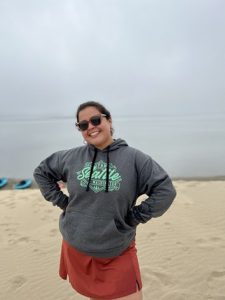Header photo courtesy of Ashley Adams.
Plastic pollution has been observed in the world’s oceans since the 1960s and since then has become more abundant in the marine environment. Larger pieces of plastic can be broken down into smaller pieces of plastic through mechanisms like wave action, animal grazing, or photo degradation. These smaller pieces of plastic are more appropriately termed microplastics and are smaller than 5mm in length and cannot be seen with the naked eye.
These microplastics are harmful to both humans and animals. Marine animals will often mistake both large and small plastics for food, which can cause false feelings of fullness. They can also become entangled in plastic debris and on a smaller cellular scale, can experience toxic effects from ingestion and exposure to the chemicals in microplastics.
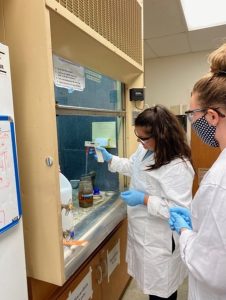
The Central Coast of California has absolutely gorgeous beaches and generally stays trash-free. However, microplastics are sneaky and can’t be seen easily. We already know that there isn’t a place on Earth that is completely plastic free as they’ve been found in the deepest part of the ocean in the Mariana Trench and on the top of the world on Mount Everest. Because of this, students in Dr. Nikki Adams’ lab at Cal Poly San Luis Obispo wanted to investigate if microplastics were present on the beaches in the Morro Bay estuary, and where in the estuary they were most abundant.
Microplastics Research Effort
We set out to answer our questions by collecting sediment (mud or sand) samples from three different beaches in the estuary: Coleman Beach, Windy Cove, and Pasadena Point. These locations all vary in proximity to creek drainage and businesses, human traffic, ecological tourism, and natural processes like wave action and water flow from currents. The diversity of these three beaches is important in helping us understand if any of these factors influence how microplastics accumulate in different sub-environments.
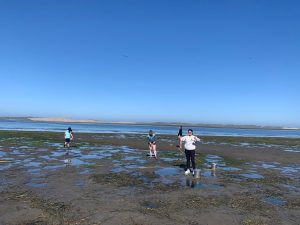
Since April 2021, we’ve been coming to the estuary each month to collect sediment samples at each beach during a low tide. In our lab, we use a special fluorescence microscope and dyes to help us view and count microplastics that may be in our samples.
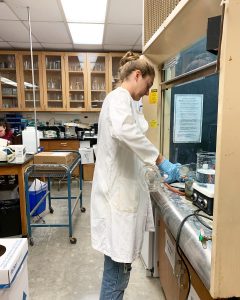
What We Learned
So far, we have found that there are microplastics at all three beaches. The most common type of microplastic has been fibers. These plastic derivatives commonly come from clothing made from polyester, abrasion from tires, and natural degradation of materials that may already be in the water like synthetic ropes on boats.
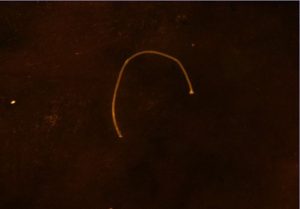
Where Do We Go From Here?
While this news is not ideal, it also is not completely surprising considering we live in a plastic world. Fortunately, our beaches are much cleaner in comparison to beaches that have been surveyed for microplastics by other researchers in various parts of the world, and there are things we can do as individuals to help mitigate this issue. Some of these things can include participating in local creek and beach clean ups, reducing plastic usage by drinking from a reusable water bottle, or wearing clothes made from cotton and linen, among many others.
We are continuing this microplastics monitoring work in Morro Bay with support from the Santa Rosa Creek Foundation.
Guest author Ashley Adams
Author Ashley Adams, a Santa Rosa Creek Foundation graduate fellow, is a 2nd year Biological Sciences graduate student at Cal Poly. She began working with the Estuary Program in November 2020 on her long-term microplastics monitoring program. In addition to overseeing this project, she also studies the effects of microplastics on the immune systems of marine invertebrates. In her free time she enjoys hiking, reading, and exploring the Central Coast. Photo courtesy of Crystal Castillo.
References:
Crichton, Ellika M., Marie Noël, Esther A. Gies, and Peter S. Ross. “A novel, density-independent and FTIR-compatible approach for the rapid extraction of microplastics from aquatic sediments.” Analytical Methods 9, no. 9 (2017): 1419-1428.
Erni-Cassola, Gabriel, Matthew I. Gibson, Richard C. Thompson, and Joseph A. Christie-Oleza. “Lost, but found with Nile red: a novel method for detecting and quantifying small microplastics (1 mm to 20 μm) in environmental samples.” Environmental science & technology 51, no. 23 (2017): 13641-13648.
Maxwell S, Helmberger, Frame Melinda K, and Grieshop Matthew. “Counterstaining to separate Nile red-stained microplastic particles from terrestrial invertebrate biomass.” Environmental Science & Technology 54, no. 9 (2020): 5580-5588.
Schmaltz, Emma, Emily C. Melvin, Zoie Diana, Ella F. Gunady, Daniel Rittschof, Jason A. Somarelli, John Virdin, and Meagan M. Dunphy-Daly. “Plastic pollution solutions: emerging technologies to prevent and collect marine plastic pollution.” Environment international 144 (2020): 106067.
Zettler, Erik R., Tracy J. Mincer, and Linda A. Amaral-Zettler. “Life in the “plastisphere”: microbial communities on plastic marine debris.” Environmental science & technology 47, no. 13 (2013): 7137-7146.
Help us protect and restore the Morro Bay estuary!
- Donate to the Estuary Program today and support our work in the field, the lab, and beyond.
The Estuary Program is a 501(c)3 nonprofit. We depend on funding from grants and generous donors to continue our work. - Support us by purchasing estuary-themed gear from ESTERO. This locally owned and operated company donates 20% of proceeds from its Estuary clothing line and 100% of Estuary decal proceeds to the Estuary Program. Thank you, ESTERO!
- Purchase items from the Estuary Program’s store on Zazzle. Zazzle prints and ships your items, and the Estuary Program receives 10% of the proceeds. Choose from mugs, hats, t-shirts, and even fanny packs (they’re back!) with our fun Estuary Octopus design, our classic Estuary Program logo, or our Mutts for the Bay logo.
Thank you for helping our beautiful, bountiful, biodiverse bay!
